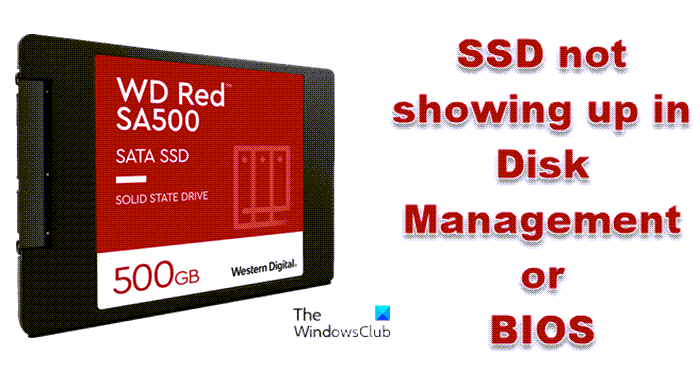By default, Windows is designed in such a way that it automatically recognizes any external drive including SSD that you insert into the system. But the real problem arises when it fails to do so.
SSD not showing up in Disk Management or BIOS
If your Windows 11/10 computer is not recognizing SSD (Solid State Drive) & it is not showing up in BIOS or Disk Management, then the following suggestions may help you: Now let’s check out all these solutions in detail.
1] Check Connection
The very first reason why Windows 11 is not able to recognize the SSD can be a loose connection. This situation mainly occurs if you are using an external SSD. As a solution to it, reconnect the SSD to the port. You can even clean the computer port before reconnecting the SSD. Once connected, check whether the system is recognizing the drive or not. If not, remove the SSD and connect it with any other system. If that system recognizes the SSD, then it indicates that there is some problem with the USB port of your main system. In such a case, you can’t do much other than get it repaired by a professional. However, if the other system fails to recognize the SSD as well, then it indicates that the drive is in need of some technical fix. Below are all the technical fixes you need to follow. Read: NVMe SSD not detected in Windows
2] Initialize Drive
An old drive, be it HDD, SSD, or USB Drive, can get corrupted due to some unavoidable reasons. In such a case, Windows 11 will fail to recognize the drive. Furthermore, Windows will also fail to recognize the drive if it has not been initialized. In either case, you will have to create a new volume to fix the problem. Here are the steps you need to follow. Now restart your system and check if this system is recognising SSD or not. Read: Couldn’t Mount File, The disk image isn’t initialized
3] Change Drive Letter and Paths
Whenever you insert a new drive into the system, Windows automatically gives it a name after the letter C. The letter that will be assigned to a drive depends on the number of drives inserted into the system. But in case, Windows hasn’t assigned any letter to the SSD, then it won’t get recognized by the system. Thankfully, you can do the process manually. To do so, here are the steps you need to follow. Restart the system, and check if the problem persists. Read: Unknown Not Initialized, Can’t initialize disk
4] Download Latest Driver Update
Outdated drivers can also trigger the mentioned problem. As a solution to it, you’ll have to download the latest driver’s update. Here are the steps you need to follow. Install the available update to resolve the problem.
5] Change System BIOS Settings
You can change the SATA operation mode if Windows 11 is not recognizing the SSD. Note: Different systems have different methods to open the BIOS window. You can check out the exact method by visiting the manufacturer’s website. Although the procedure will be similar in all the systems, below are the steps to get the work done on a Dell system. Go to System Configuration.
Choose SATA Operations, and set it to AHCI.
Click on Apply, and exit the BIOS. If you are still facing the issue, the probability is very high that there is some problem with the SSD itself. In such a case, you can’t do anything other than to get it replaced from the place you have bought it. Read: Hard Drive not showing up on Boot Menu.
Why is my SSD not being detected?
The SSD will not be detected if the connector is damaged, or if there’s an incorrect connection. A defective decide driver can also cause this issue. It is very simple to resolve this problem.
How do I get BIOS to recognize a new SSD?
If the BIOS doesn’t recognize a new SSD, you need to manually initialize the driver. You can even download the latest driver update or work with the BIOS settings to fix the problem.

